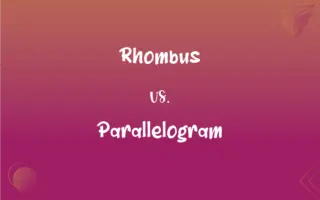Proximity vs. Distance: What's the Difference?
Edited by Aimie Carlson || By Janet White || Updated on January 25, 2024
Proximity refers to the nearness or closeness in space, time, or relationship, while distance denotes the extent of space between two points, objects, or time periods.

Key Differences
Proximity is a term that implies closeness or nearness in space, time, or relationships. It suggests a small or negligible gap between objects or entities. Conversely, distance indicates a measurable space between two points or objects, often implying a larger gap or separation. While proximity suggests intimacy or immediacy, distance denotes separation or detachment.
In physical terms, proximity could refer to objects that are within a short range of each other, highlighting their accessibility or immediate relevance. Distance, on the other hand, refers to a more substantial spatial separation, emphasizing the extent of space that needs to be traversed to connect the points.
In the context of relationships, proximity suggests a close bond or connection, potentially both in a physical and emotional sense. Distance in relationships can imply physical separation, as well as emotional or psychological detachment, highlighting a lack of closeness or connection.
Proximity also plays a key role in various fields like geography, where it pertains to the nearness of locations or features to each other. In contrast, distance is a fundamental concept in mapping and navigation, focusing on the length of the path between two points.
Technologically, proximity can refer to the closeness of devices or systems, impacting their interaction and connectivity. Distance, in technology, often relates to the range at which devices or systems can effectively communicate or interact, underlining the limitations imposed by physical separation.
ADVERTISEMENT
Comparison Chart
Definition
Nearness in space, time, or relationship.
Extent of space or time between two points.
Implication in Space
Close physical spacing between objects or points.
Significant spatial separation between points.
Usage in Relationships
Suggests closeness or immediate connection.
Implies separation or lack of connection.
Importance in Technology
Crucial for interaction and connectivity of devices.
Defines the range or limit of communication.
Role in Navigation
Proximity indicates destinations within a short range.
Distance measures the length of a journey.
ADVERTISEMENT
Proximity and Distance Definitions
Proximity
In technology, proximity refers to the closeness of devices or systems.
The proximity sensor in the phone turns off the screen during calls.
Distance
In relationships, distance implies a lack of closeness or connection.
There has been an emotional distance between them since the argument.
Proximity
Proximity can imply nearness in terms of relevance or similarity.
The proximity of their views on politics brought them together.
Distance
Distance is the measurement of space between two points or objects.
The distance between New York and Los Angeles is approximately 2,450 miles.
Proximity
Proximity denotes closeness in terms of relationships or connections.
Their emotional proximity made them best friends.
Distance
Distance in communication means the extent to which messages must travel.
The distance of the signal affects the quality of the broadcast.
Proximity
Proximity is the state of being near in space or time.
The proximity of the coffee shop to my office makes it a convenient meeting place.
Distance
Distance can refer to a far-off point or period in time.
We planned our vacation months in advance, but it still feels like a distance away.
Proximity
Proximity in geography indicates closeness of locations.
The hotel's proximity to the beach makes it popular among tourists.
Distance
In sports, distance can refer to the length of a race or throw.
The runner excelled in long-distance races.
Proximity
The state, quality, sense, or fact of being near or next; closeness
"Swift's major writings have a proximity and a relevance that is splendidly invigorating" (M.D. Aeschliman). See Usage Note at redundancy.
Distance
The extent of space between two objects or places; an intervening space.
Proximity
Closeness; the state of being near as in space, time, or relationship.
The proximity of the heat source allowed it to be detected by the sensor.
You and I live in close proximity.
Proximity
The quality or state of being next in time, place, causation, influence, etc.; immediate nearness, either in place, blood, or alliance.
If he plead proximity of bloodThat empty title is with ease withstood.
Proximity
The property of being close together
Proximity
The region close around a person or thing
Proximity
A Gestalt principle of organization holding that (other things being equal) objects or events that are near to one another (in space or time) are perceived as belonging together as a unit
FAQs
Can proximity apply to online relationships?
Yes, proximity can refer to the closeness of online interactions or connections.
Is distance always physical?
No, distance can also be emotional, temporal, or symbolic.
What does proximity mean in a geographical context?
In geography, proximity refers to the closeness or nearness of locations to each other.
How does proximity affect business locations?
Proximity to customers or resources can significantly impact a business's success.
How is distance measured?
Distance is measured in units like miles or kilometers, indicating the space between two points.
Can proximity influence social interactions?
Yes, proximity can enhance the likelihood of social interactions and relationships.
Is distance relevant in online education?
Distance is a key factor in online education, as it enables learning across long distances.
What is the importance of distance in communication technology?
Distance determines the range and effectiveness of communication signals in technology.
Does proximity always imply a positive relationship?
Not necessarily; proximity indicates closeness, which can be positive or negative.
Can distance be psychological?
Yes, psychological distance refers to the perceived remoteness of ideas, people, or events.
Can proximity influence personal preferences?
Yes, proximity to certain environments or experiences can shape personal preferences.
How does distance affect transportation planning?
Distance is crucial for planning routes, travel time, and transportation costs.
How does proximity impact environmental studies?
Proximity to pollution sources or natural resources is vital in environmental impact studies.
How is distance used in astronomy?
Distance in astronomy measures the vast spaces between celestial bodies.
How does proximity relate to cultural similarities?
Proximity often correlates with cultural similarities due to shared geographical and social influences.
What is the significance of distance in history?
Distance can affect historical events, like the spread of empires or communication speed.
How does distance affect remote work?
Distance in remote work can challenge communication but also offers flexibility and global collaboration.
Can proximity affect mental health?
Yes, proximity to supportive relationships or stressful environments can impact mental health.
What role does proximity play in marketing?
Proximity to target audiences can influence marketing strategies and campaign effectiveness.
Is distance important in network design?
Distance is crucial in network design for signal strength and connectivity.
About Author
Written by
Janet WhiteJanet White has been an esteemed writer and blogger for Difference Wiki. Holding a Master's degree in Science and Medical Journalism from the prestigious Boston University, she has consistently demonstrated her expertise and passion for her field. When she's not immersed in her work, Janet relishes her time exercising, delving into a good book, and cherishing moments with friends and family.
Edited by
Aimie CarlsonAimie Carlson, holding a master's degree in English literature, is a fervent English language enthusiast. She lends her writing talents to Difference Wiki, a prominent website that specializes in comparisons, offering readers insightful analyses that both captivate and inform.







































































